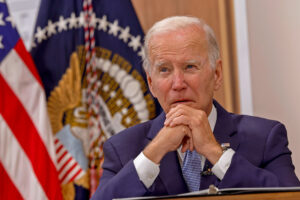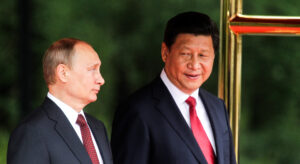With a New World Order lurking on the horizon, will America play nothing more than a supporting role? That is certainly the impression given by recent reports in the US and beyond. While the Ukraine crisis has helped to renew purpose among many nations in the West, the Global South, we’re told, recognises that the post-Cold War era is finished. The international system is fragmenting into “a multipolar world”, and the age of US dominance “may be coming to an end”.
Amplifying this view is the emergence of a renewed Sino-Russian axis, which, according to Vladimir Putin himself, has “consistently worked to create an equitable, open and inclusive regional and global security system”. China’s CCP-controlled Global Times is equally optimistic, suggesting that the Russia-Ukraine conflict serves “as a catalyst for the burial of American hegemony”. A recent University of Cambridge study seemed to confirm this: it found that, for the first time, developing countries are now more supportive of Russia and China than the US.
Yet while America’s unipolarity is undoubtedly fragile, we should be cautious about what this means — particularly when interpreting the motivations of states in the Global South, the symptoms of American decline, and the fragmentary potential of the new Sino-Russian relationship. Most obviously, states in the Global South are not some homogeneous non-Western “Other”, but a collection of different countries with competing interests. The historian Timothy Garton Ash recently argued that the West urgently needs a “new narrative persuasive to countries like India”. This may seem like a harmless observation to make, but it confuses soft power’s capacity to woo a diverse range of self-interested nation states: what is persuasive to India isn’t necessarily persuasive to Indonesia.
Rather than acting as a unified bloc, it is far more likely that states will play sides off against each other, especially as the division between the West and a China-centred global economy gathers pace. Indeed, their capacity to withhold support is a rational strategy to enhance their bargaining power and to win concessions from the West. It is a form of enticement, not indictment. In India, for example, record imports of Russian oil have boosted Narendra Modi’s position with key actors, such as the European Union, which has rapidly accelerated its free-trade negotiations with Delhi. This follows the rapid conclusion of a major semiconductor supply chain and innovation partnership with the US, which will be followed this summer with a visit by Modi, designed to shore up the two countries’ defence and economic links.
Meanwhile, those who posit the decline of America, and by extension the liberal world order, often get key metrics wrong. For instance, it has been argued that as the unipolar moment fades, so will the dollar’s international reserve currency status. Writing in UnHerd, Thomas Fazi recently argued that Western sanctions on Russia have “enhanced the yuan’s reserve currency status”, while Bloomberg reported that the dollar has reached a “critical inflection point”. Even the IMF has signalled alarm.
However, the use of the dollar is based as much on geopolitics as it is on economics. Foreign investors will continue to use the currency not just because of its incredible liquidity as a store of value and medium of global exchange, but because of the US’s legal and governance infrastructure. It remains, after all, the currency of choice in foreign-exchange swap transactions, accounting for nearly half of the $6.6 trillion daily foreign-exchange turnover. Of allocated foreign-exchange reserves in late 2022, the dollar accounted for 60% of the world’s total. The Euro, by contrast, stood at 20%. The Chinese Renminbi? 3%.
The case for a renewed Sino-Russian axis is equally unfounded. Although Putin recently hosted his “dear friend” Xi at the Kremlin, underlying this friendship is the stark reality of a deepening Russian vassalage to Xi’s China. A loss of Russian prestige and status in Ukraine, and by extension an American victory, would prove a mortal blow to Putin’s project of contesting the world order that, from the Kremlin’s perspective, represents a greater civilisational struggle. Given this existential framing, Putin has little choice but to deepen his reliance on China as a market for Russian commodities and supplies for his war machine (via useful proxies such as North Korea).
Moreover, simmering tensions within the Sino-Russian axis already exist. The Siberian Pacific seaboard, which includes regions such as the Russian Far East and the Amur river basin, is rich in natural resources, such as timber, minerals and fisheries. China’s infrastructure and development projects in the region, including through its Belt and Road Initiative, have been primarily economic. As Moscow’s dependency grows, China may seek to salami-slice Russian interests, including the eventual reabsorption of the Pacific Seaboard. And this could lead to a weakening of the Federation as a whole, as well as its disintegration in the long term. None of the Central Asian states have supported the invasion of Ukraine, and are increasingly distancing themselves from Putin’s integration projects. As such, despite proclamations of brotherly love, the chaotic Sino-Russian axis remains unlikely to become a “soft power” pole around which much of the Global South will seek to organise.
The US, meanwhile, retains an incredible capacity to leverage its military power into structuring the international preferences of politically equal but security subordinate states. The threat posed by the emergent Sino-Russian axis increases its capacity to corral powers as diverse as Sweden, Finland, Taiwan and Japan under its strategic superintendence, all of whom look to the US for protection. Underlined by its newly energised Aukus deal, and growing role within Nato, America’s status in major centres of world power remains as strong as it did in the early post-Cold War period.
Zbigniew Brzezinski’s masterful dissection of world politics, The Grand Chessboard (1997), recognised that Eurasia has long been the centre of world power. As a consequence, he identified that “the three grand imperatives of imperial geostrategy are to prevent collusion and maintain security dependence among [Eurasian] vassals, to keep tributaries pliant and protected, and to keep the barbarians from coming together”. The “most dangerous scenario”, Brzezinski argued, “would be a grand coalition of China, Russia, and perhaps Iran, an ‘antihegemonic’ coalition united not by ideology but by complementary grievances”.
How can a US-led West keep the “barbarians” from coming together? By 1943, the US State Department had recognised that Nazi Germany could not win the global struggle for mastery, so it planned the kind of world order it wanted, which included incorporating a defeated Germany within a new, American-led global order. As the Ukraine crisis rumbles on, the West’s programme is clear, with the nascent expansion of Nato along Russia’s borders and the likely emergence of Ukraine as a fearsome buffer state. Under this strategy, in 10 years, Poland will become the preeminent land power in Europe.
What “carrots” can it leverage? While history never repeats itself, it often rhymes. As in 1943, it is clear that Putin cannot win the Ukraine war. With this in mind, it is not inconceivable that a post-Putin European security order could seek to re-incorporate Russia into a new security and economy architecture. This new “grand bargain” would seek to settle the intersection of historical grievances and fears over status and security. Through institutional reform and transformation, it would attempt to entice a post-Putin Russia into its orbit. Doing so would settle many grand strategic dilemmas driving post-Cold War Nato expansion and Russian hostility. This new post-Putin security order would be right on Beijing’s doorstep, across the 2,615 miles between China and Russia.
In a tripolar world, with America, Russia and China operating as individual actors, any alliance between two great powers inevitably spells doom for the third. And by wedging apart the developing Sino-Russian coalition, America would also be free to “buck-pass” its superintendence to regional European powers, allowing it to finally move more decisively in its long desired “strategic pivot” to East Asia. The popular narrative of America’s secular decline therefore seems overblown. The US enjoys the Pacific and Atlantic moats, and regional hegemony in the Americas. China and Russia, on the other hand, live in a much rougher neighbourhood, and there’s no reason to think their axis could not be wedged apart. Whether that takes a year or a decade, it seems more likely that America will still be front and centre, playing its role as a global protagonist.
Disclaimer
Some of the posts we share are controversial and we do not necessarily agree with them in the whole extend. Sometimes we agree with the content or part of it but we do not agree with the narration or language. Nevertheless we find them somehow interesting, valuable and/or informative or we share them, because we strongly believe in freedom of speech, free press and journalism. We strongly encourage you to have a critical approach to all the content, do your own research and analysis to build your own opinion.
We would be glad to have your feedback.
Source: UnHerd Read the original article here: https://unherd.com/



